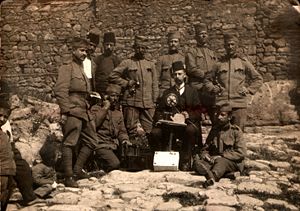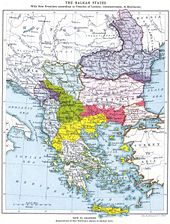Second Balkan War
| Second Balkan War | |||||||
|---|---|---|---|---|---|---|---|
| Part of Balkan Wars | |||||||
 Serbian forces during the Second Balkan War. |
|||||||
|
|||||||
| Belligerents | |||||||
| Commanders | |||||||
| Strength | |||||||
Total: 1,087,000 |
|||||||
|
|||||
The Second Balkan War was fought in 1913 between Bulgaria on one side and its First Balkan War allies Serbia, Greece, and Montenegro on the other side, with Romania and the Ottoman Empire intervening against Bulgaria. The outcome turned Serbia, an ally of the Russian Empire, into an important regional power, alarming Austria-Hungary and thereby indirectly providing an important cause for World War I.
Contents |
Background - The First Balkan War
During the First Balkan War, the Balkan League (Serbia, Montenegro, Greece, and Bulgaria) succeeded in conquering the European provinces of the Ottoman Empire (Albania, Macedonia and Thrace), leaving the Ottomans with only the Chatalja and Gallipoli peninsulas. The Treaty of London, signed on 30 May 1913, which ended the war, acknowledged the Balkan states' gains west of the Enos-Medea line and created an independent Albania.
However, the treaty did not satisfy anyone. The Balkan states had made no preliminary agreement on the partition of the conquered territories, especially with regards to Macedonia, and the London Conference simply recognized the status quo, whereby the territories went to the occupying power. Bulgaria felt that their territorial rewards from the war, particularly in Macedonia, were insufficient, and laid claim to the important city of Salonika, where a Bulgarian regiment was already stationed. Greece and Serbia were already displeased at being forced to evacuate Albania, and responded to the perceived Bulgarian threat by entering into negotiations, ostensibly aimed at preventing Bulgarian expansion. They settled their mutual differences and signed a military alliance on May 1, 1913, followed by a treaty of "mutual friendship and protection" on May 19/June 1, 1913. A further dispute of Bulgaria was with Romania, over the latter's claim on the Bulgarian fortress of Silistra on the Danube river, as the price for their neutrality in the First Balkan war.
Russian arbitration, provided for in the 1912 Serbo-Bulgarian treaty, was progressing slowly, as Russia didn't wish to lose either of its Slavic allies in the Balkans. During the negotiations, skirmishing continued in Macedonia, mainly between Serbian and Bulgarian troops. On June 16, the Bulgarian high command, without notifying the government, ordered Bulgarian troops to attack Serbian and Greek positions, and declarations of war ensued.
Bulgaria hoped to acquire all of Bulgarian Macedonia and dominate the Balkans, as envisaged in the Treaty of San Stefano, while Serbia and Greece hoped to take larger portions of Macedonia and prevent Bulgarian hegemony.
Forces

The army of the Kingdom of Bulgaria had 500,000 men divided into five armies, deployed over 500 km front from the Danube river on the North, to the Aegean Sea on the South.
The army of the Kingdom of Serbia accounted for 230,000 men divided into three armies, its main force deployed on the Macedonian front along the Vardar river and Skopije. The army of the Kingdom of Greece had 120,000 men, mainly around Salonica. The Kingdom of Montenegro sent one division (12,000 men) on the Macedonian front.
The Kingdom of Romania mobilized 500,000 men, allocated in five corps. The Ottoman Empire entered the war with an army of 255,000 men.
The Beginning of the Second Balkan War
The main Bulgarian attack was planned against the Serbs with their 1st, 3rd, 4th and 5th Armies, while the 2nd Army was tasked with an attack towards Greek positions at Salonika. The Bulgarians were outnumbered on the Greek front and the low-level fighting soon turned into Greek attack all along the line on 19 June. The Bulgarian forces immediately withdrew from their positions north of Salonika (except the isolated Salonika garrison which was quickly overrun) to defensive positions between Kilkis and Struma river. The plan was to quickly destroy the Serbian army in central Macedonia by concentrated attack; due to the Romanian involvement from the North it did not succeed and the Bulgarians were stopped.
Battle of Kilkis-Lahana
The Bulgarian 2nd Army in southern Macedonia commanded by General Ivanov held a line from Lake Doiran (a key battlefield for British troops three years later) south east to Lakes Langaza (modern Lake Koronia) and Beshik (modern Lake Volvi), then across to the port of Kavala on the Aegean. The army had been in place since May, and had fought at the siege of Adrianople in the First Balkan War. Bulgarians claim that their troops were overextended and that they numbered no more than 40,000 men in two weak divisions. Many of the gaps were filled with recruits from the local population. The Greeks estimated their opponents at at least 80,000 men. The Greek army, commanded by King Constantine I, had nine divisions and a cavalry division (120,000 men), outnumbering the Bulgarian forces, which were however heavily fortified.
At Kilkis the Bulgarians had constructed strong defenses, including captured Ottoman guns which dominated the plain below. On 3 July the Greek 4th, 2nd and 5th divisions attacked across the plain in rushes supported by artillery. They suffered heavy casualties but by the following day had carried the trenches. Meanwhile on the Bulgarian left the Greek 7th Division had captured Nigrita and the 1st and 6th divisions Lahana. On the Bulgarian right Evzoni captured Gevgelija and the heights of Matsikovo. As a consequence the Bulgarian line of retreat through Doiran was threatened and Ivanov's army began a desperate retreat which at times threatened to become a rout. Reinforcements in the form of the 14th Division came too late and joined the retreat towards Strumica and the Bulgarian border. The Greeks captured Doiran on 5 July but were unable to cut off the Bulgarian retreat through Struma pass. On 11 July the Greeks joined up with the Serbs and then pushed on up the Struma River until they reached Kresna Gorge on 24 July. At this point the exhausted Greeks had overstretched their supply lines, and were forced to halt.
Bregalnica, Kalimantsi and Kresna Gorge
On the front in central Macedonia the Serbs pushed Bulgarian forces eastwards at the battle of Bregalnica (30 June - 9 July). Meanwhile on the north the Bulgarians started to advance towards Serbian town of Pirot (near the Serbian - Bulgarian border) and forced Serbian Command to send reinforcements to the 2nd Army defending Pirot and Nis. This enabled Bulgarians to stop the Serbian offensive in Macedonia at Kalimantsi on 18 July.
Meanwhile after the situation on the Serbian front calmed down, King Constantine believing that the Bulgarians had been already defeated he ordered the Greek army to march further into Bulgarian territory and take the Bulgarian capital Sofia. King Constantine wanted a decisive victory on this war despite the objections with Eleftherios Venizelos.
The Greek army thought that they were already victorious and without precautions they continue marching deeper into Bulgarian territory. So at Kresna the Greeks were ambushed by the Bulgarian 1st and 2nd Army that had already taken defensive positions there.
Both Greeks and Bulgarians were in stalemate and had sustained heavy casualties during the previous days of fighting. At the end the Bulgarian and Greek governments were equally desirous for peace so the war between them was over.
| Battles of the Second Balkan War | ||||||||
| Name | Defending | Commander | Attacking | Commander | Date | Victor | ||
| Kilkis-Lahanas | Bulgaria | Nikola Ivanov | Greece | Constantine I | 19–21 June 1913 (O.S.) | Greece | ||
| Doiran | Bulgaria | Nikola Ivanov | Greece | Constantine I | 22–23 June 1913 (O.S.) | Greece | ||
| Bregalnica | Serbia | Bulgaria | 17–25 June 1913 (O.S.) | Serbia | ||||
| Battle of Kalimantsi | Bulgaria | Serbia | 15–18 July 1913 (O.S.) | Bulgaria | ||||
| Battle of Kresna Gorge | Bulgaria | Greece | Constantine I | 8–18 July 1913 (O.S.) | Bulgaria (Truce) | |||
End of the War

Despite stabilising the front in Macedonia, the Bulgarian government's acceptance of an armistice was driven by events far from Macedonia. Romania invaded on 27 June/10 July, occupying the undefended Southern Dobruja and marching through Northern Bulgaria to threaten Sofia. The Ottoman Empire also took advantage of the situation to recover some of their former possessions in Thrace including Adrianople (which the Bulgarians abandoned on 23 July without firing a shot). Ottoman troops marched into Yambol and Western Thrace. Because Bulgarian troops had all been allocated to the front with Serbia and Greece, the Ottoman and Romanian armies suffered no combat casualties, although both suffered heavily from a cholera outbreak.
A general armistice was agreed to on 18/31 July, 1913, and the territorial spoils divided in the Treaty of Bucharest and the Treaty of Constantinople. Bulgaria lost most of the territories gained in the First Balkan War including the southern Dobrudja (to Romania), most of Macedonia, and Eastern Thrace (to the Ottomans), while retaining Western Thrace, its Aegean outlet, with the port of Dedeagach. Serbia made gains in northern Macedonia, while Greece gained the region's southern half
The boundary settlements of the Treaties of Bucharest and Constantinople were only temporary; ten months later the fighting was renewed with the start of the First World War.
Notes
References
- Erickson, Edward J.; Bush, Brighton C. (2003). Defeat in Detail: The Ottoman Army in the Balkans, 1912–1913. Greenwood Publishing Group. ISBN 0275978885.
- Hall, Richard C. (2000). The Balkan Wars, 1912–1913: Prelude to the First World War. Routledge. ISBN 0415229464.
- Schurman, Jacob Gould (2004). The Balkan Wars 1912 To 1913. Kessinger Publishing. ISBN 1419153455.